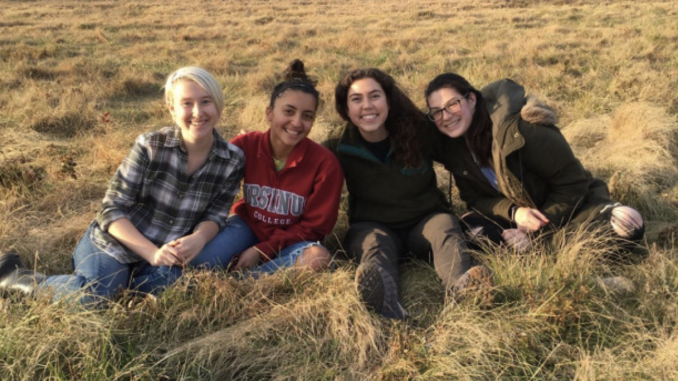
Chase Portaro: chportaro@ursinus.edu
One Grizzly bear weighs about 600 pounds, which seems like a lot, but not when you compare it to the 1,700 pounds of food waste that Ursinus Grizzlies produce every week in Upper Wismer alone – not even counting the food waste from The Commons or Lower Wismer.
That’s why Environmental Studies Professor Dr. Leah Joseph and her capstone class are “Talking Trash” to solve this 1,700 pound bear of a problem looming around Ursinus’s campus. Dr. Joseph’s
fall semester class, titled “Talking Trash,” partnered with the Food Sustainability Fellows last semester to explore options for turning that leftover food waste into a compost.
Environmental science major Amanda Laucks, ‘23 is leading the group of students interested in reducing Ursinus’s waste output. She said, “I was a part of three different organizations who were all looking to do [a compost]. I am a food fellow with [Director of Sustainability] Kate Keppen, then I’m in the Capstone waste class, and I’m also on the board of Wismer on Wheels, so there’s interest in composting from a bunch of different groups on campus.”
Kate Keppen, Director of Sustainability explained, “The reason there is so much interest in getting food items out of the waste stream comes from the benefit of that closed system. It came from the earth, so let’s get it back into the earth.” She added, “All of this food will eventually be broken down, and it will be turned into compost which can then go to gardens and farms to enrich the soil.”
Currently, the food scraps from Wismer enter the trash stream along with all the other waste the campus produces. After that waste leaves Ursinus, it’s brought to a waste energy plant to be incinerated. Keppen said, “What that means is it goes about twenty minutes down the road, and it’s burned, and that heat from burning all that waste turns turbines, and that electricity goes out to the grid.”
From this process, Keppen said, “Our carbon footprint from that is 0.” Ursinus’s waste removal system still produces carbon dioxide and methane fumes and also leaves behind burned trash known as “bottom ash,” which eventually ends up in landfills. But after the waste gets burned to produce energy, someone buys that energy from PECO (Pennsylvania Electric Company) grid. “Then the carbon footprint gets placed upon the purchaser of that electricity. We are obviously in southeastern [Pennsylvania], so theoretically we could be purchasing energy from our own trash being burned,” Keppen said.
So in reality, Ursinus’s carbon footprint isn’t being neutralized, it’s just being passed off, and Ursinus could be passing lves every time they purchase energy from PECO. Keppen said, “There are tremendous flaws in the model, and again, this is a universally held [model] of how people are trying to tackle the climate crisis. So, I say it’s the best we got, until we get better.” She said, “there’s a term called best management practices. . . but I often think we should be using the term better management practices.”
Environmentalists on campus have identified Wismer’s waste output as low-hanging fruit that could easily reduce Ursinus’s carbon footprint. Keppen said, “If we are able to take that out, we decrease how much waste is being incinerated,” which would actually lessen the campus’s overall carbon footprint, instead of passing the buck to someone else.
Creating a compost is a complex process, but the trial period of weighing the waste has already been completed. In the spring of 2022, two gloved students stood at the dish pit in Upper Wismer
and took plates to scrape the waste onto a scale. Those students were part of the joint effort of the Food Fellows and Dr. Joseph’s capstone class to gauge how much waste Ursinus produces.
Laucks said, “[Last] semester was just about getting it started. So right now we’re working on compiling a document that just lays out all the different methods that future students can take to creating a compost.”
The team of environmentalists set the compost plan into motion, but in order for it to become a reality, Keppen explained the entire campus should have the same interest in reducing the school’s waste output. “The onus of the class is not to ‘solve it.’ That’s for all of us to do. But they’re spending thirteen weeks exploring this topic,” she said.
The group may not have solved the food waste issue in one semester, but they’ve made important information available to the student body. Keppen finished, “We need solutions that make sense to everyone, and if it doesn’t make sense to people, no one is going to buy into it. You don’t need to have a physics degree to see that there’s still carbon moving through the system.”
The system is far from perfect, but the beginning stages of forming a solution is recognizing that things aren’t perfect. Until the compost project is officially implemented, Laucks offered some advice on reducing waste in Wismer. “When there’s something new, the first time you try it, just get a small amount to make sure you like it then go back.”
